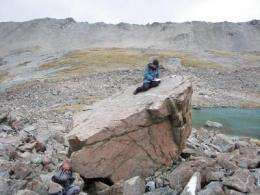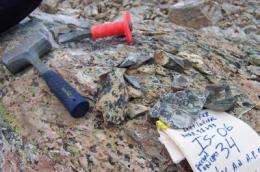Study adds new clue to how last ice age ended

As the last ice age was ending, about 13,000 years ago, a final blast of cold hit Europe, and for a thousand years or more, it felt like the ice age had returned. But oddly, despite bitter cold winters in the north, Antarctica was heating up. For the two decades since ice core records revealed that Europe was cooling at the same time Antarctica was warming over this thousand-year period, scientists have looked for an explanation.
A new study in Nature brings them a step closer by establishing that New Zealand was also warming, indicating that the deep freeze up north, called the Younger Dryas for the white flower that grows near glaciers, bypassed much of the southern hemisphere.
"Glaciers in New Zealand receded dramatically at this time, suggesting that much of the southern hemisphere was warming with Antarctica," said study lead author, Michael Kaplan, a geochemist at Columbia University's Lamont-Doherty Earth Observatory. "Knowing that the Younger Dryas cooling in the northern hemisphere was not a global event brings us closer to understanding how Earth finally came out of the ice age."
Ice core records show that warming of the southern hemisphere, starting 13,000 years ago, coincided with rising levels of the heat-trapping gas, carbon dioxide. The study in Nature is the first to link this spike in CO2 to the impressive shrinking of glaciers in New Zealand. The scientists estimate that glaciers lost more than half of their extent over a thousand years, and that their creep to higher elevations was a response to the local climate warming as much as 1 degree C.

To reconstruct New Zealand's past climate, the study's authors tracked one glacier's retreat on South Island's Irishman Basin. When glaciers advance, they drag mounds of rock and dirt with them. When they retreat, cosmic rays bombard these newly exposed ridges of rock and dirt, called moraines. By crushing this material and measuring the build-up of the cosmogenic isotope beryllium 10, scientists can pinpoint when the glacier receded. The beryllium-10 method allowed the researchers to track the glacier's retreat upslope through time and indirectly calculate how much the climate warmed.
The overall trigger for the end of the last ice age came as Earth's orientation toward the sun shifted, about 20,000 years ago, melting the northern hemisphere's large ice sheets. As fresh melt water flooded the North Atlantic Ocean, the Gulf Stream weakened, driving the north back into the ice age. During this time, temperatures in Greenland dropped by about 15 degrees C. For years, scientists have tried to explain how the so-called Younger Dryas cooling fit with the simultaneous warming of Antarctica that eventually spread across the globe.
The Nature paper discusses the two dominant explanations without taking sides. In one, the weakening of the Gulf Stream reconfigures the planet's wind belts, pushing warm air and seawater south, and pulling carbon dioxide from the deep ocean into the air, causing further warming. In the other, the weakened Gulf Stream triggers a global change in ocean currents, allowing warm water to pool in the south, heating up the climate.
Bob Anderson, a geochemist at Lamont-Doherty who argues the winds played the dominant role, says the Nature paper adds another piece to the puzzle. "This is one of the most pressing problems in paleoclimatology because it tells us about the fundamental processes linking climate changes in the northern and southern hemispheres," he said. "Understanding how regional changes influence global climate will allow scientists to more accurately predict regional variations in rain and snowfall."
Provided by Columbia University


















